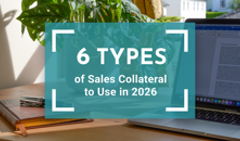Presentations have come a long way, from Ancient times oral storytelling and painted visuals to today’s sophisticated, interactive digital experiences. Yet, the purpose of a presentation has remained consistent throughout history. Whether it was a Greek philosopher persuading a crowd, a medieval monk teaching scripture, or a modern marketer pitching a product, presentations have always aimed to inform, inspire, engage, and persuade.
What has changed are the tools and formats we use. So let’s talk about the tools and tips to create powerful multimedia presentations.
What Is a Multimedia Presentation?
A multimedia presentation is a dynamic way to share information, stories, or ideas. It incorporates different types of media, such as text, images, video, audio, animation, and more to create a rich and enticing experience.
✨At its core, a presentation is a structured act of storytelling designed to move an audience.
Check out an interactive presentation that grabs your audience's attention with its beautiful design and engaging media.
Key Benefits of a Multimedia Presentation
A multimedia presentation offers powerful opportunities to communicate your message effectively. Here are the key advantages of enhancing a presentation with multimedia that can elevate your work and captivate your audience.
🚀Captures interest
Let’s face it—walls of text don’t stand a chance against visuals, videos, and motion. Multimedia presentations instantly draw people in and make them want to stick around.
🎮Keeps people engaged
When you combine images, audio, animation, and interactivity, your message comes to life. That keeps your audience curious, involved, and far less likely to zone out halfway through.
💡Simplifies complex ideas
Charts, videos, and GIFs help break down complex ideas into something easy to understand, even if there are lots of numbers or historical facts. Your clients will thank you for making even the most intricate data easy to follow and remember.
🎨Appeals to different learning styles
Some people learn by reading, others by watching or doing. A multimedia format covers all those learning styles, so more people can actually absorb what you’re saying. And they will be grateful to you for thinking about them.
✨Adds a modern professional touch
A neat interactive presentation shows that you care about your message and your audience. It helps build trust and credibility, whether you're pitching an idea, teaching your students, or simply sharing an idea with your colleagues.
📌Boosts retention
People remember what they see and hear better than what they read alone. By engaging multiple senses, multimedia presentations make your message more memorable.
Types of Media to Add to Your Presentation

A multimedia presentation is built from interactive elements that make it rich, captivating, and packed with valuable information. Here’s a look at the types of media you can add to your presentation to make it more enticing.
⭐Text and typography: building clarity and structure
Words still matter! And they are the foundation of your presentation. Choosing the right fonts, sizes, and colors helps your audience follow along and absorb the message. Clear, well-designed text sets the tone and keeps things readable.
⭐Images and graphics: telling a visual story
A great image can say more than a paragraph of text. Images, photos, and charts (the stars of any presentation) help visualize ideas, spark emotion, and make your message stick.
⭐Audio: adding emotion and depth
Music, voiceovers, or subtle sound effects can breathe life into your presentation. Sound sets the mood and helps create a deeper emotional connection with your audience.
⭐Video: boosting engagement and understanding
Videos are perfect for showing rather than telling. Whether it’s a product demo, testimonial, or explainer clip, they help your content feel compelling and real. Plus, videos catch your readers' attention and keep them engaged from the beginning to the end of your presentation.
⭐Animation: direct focus and energizing your slides
A little motion goes a long way. Animations can highlight key points, guide the viewer’s attention, and make your presentation feel more interactive and even fun if you want to create a lighter mood.
Best Tools to Create Multimedia Presentations
There’s no shortage of multimedia presentation software out there, but not all of it is built for multimedia magic. Here’s a quick guide to some of the best platforms for creating catchy, interactive presentations, plus tips on when to use each one.
#1 Google Slides / PowerPoint. For reliable, all-purpose use
Still going strong, these two classics now support multimedia elements like video and audio. So if you need to create simple and neat presentations to share with your colleagues or partners and you don’t have much time for design, go with Google Slides or PowerPoint.
🟢 Best for: corporate presentations, team meetings, client decks.
🎯 Use it when: You need something familiar, collaborative, and cloud-friendly.
#2 FlippingBook. For turning documents into rich interactive experiences
FlippingBook transforms your static PDFs into sleek interactive presentations and pitch decks with a realistic page flip effect. To make your presentations even more powerful, you can enhance them with interactivity, such as videos, GIFs, image galleries, and forms & quizzes. Perfect for digital flipbooks, marketing brochures, sales proposals, or online catalogs that feel more like mini websites than old-school slides.
With FlippingBook, there's a page flip mode for every audience:
Automatic page turning. You can set the pages of your presentation to turn automatically. This feature gives you even more flexibility when presenting your documents, keeping your hands free.
The traditional flipbook two-page layout. It's called a flipbook for a reason. If you want to give your audience a lifelike open-book experience, stick to the classic two-page layout.
The album-like one-page flip mode. Once you try it, you may never want to go back. The layout actually works well for wide and standard pages alike—you can draw client attention to one page at a time.
Business Aircraft Market Forecast (2011–2030)
The professional slide mode. Don't judge a book by its page flip effect. Sometimes, displaying your content as slides is the best way to showcase it—your presentation will still have the professional look and feel that FlippingBook offers.
Sports, Outdoor, and Lifestyle Portfolio
🟢 Best for: marketing, sales, product showcases, branded documents.
🎯 Use it when: You want to impress and engage your clients, partners, and investors.
#3 Canva. For beautifully designed, media-rich slides
Canva makes it easy to create presentations with drag-and-drop tools, animated transitions, and embedded videos or audio. It’s beginner-friendly but powerful enough for professionals.
🟢 Best for: webinars, social media presentations, storytelling.
🎯 Use it when: You want full design control and built-in stock visuals on hand.
#4 Prezi. For zooming, dynamic storytelling
Prezi breaks away from the traditional slide-by-slide flow. It uses zooming paths and spatial movement to connect ideas visually—great for storytelling, educational content, or big-picture thinking.
🟢 Best for: teaching, TED-style talks, workshops
🎯 Use it when: You want to wow your audience with a non-linear narrative.
#5 Genially. For interactive, gamified presentations
Genially offers templates with built-in interactivity—clickable hotspots, quizzes, and games. It’s ideal when you need more than just visuals to keep people engaged.
🟢 Best for: e-learning, onboarding, internal training
🎯 Use it when: You want your audience to interact and respond in real time.
Tips to Make Your Presentation Shine, without Overwhelming Your Audience
Multimedia is a powerful tool—but like any good thing, it works best in balance. Here are a few easy tips to help you get the most out of it without overloading your slides (or your viewer).
🎯Keep it purposeful. Don’t add video, sound, or animation just because you can. Ask yourself: Does this help explain my point or make the message clearer? If yes, go for it! If not, skip it.
🌟Use high-quality media. Make sure your visuals are high resolution and properly formatted. Always preview on a large screen to ensure everything looks polished and intentional. High-quality media shows that you’re a professional and that you think through every detail of your work.
🎬Add short, focused video clips. A 30-second demo or testimonial can work wonders. Long videos? Not so much. Make it brief and relevant to keep people tuned in.
🧠Give your content room to breathe. Spread out your visuals, use whitespace, and let each element have its moment. Add no more than one or two interactive elements on a slide: balance interactive content with static content to give your audience time to process information.
🖱️Make it interactive—but intuitive. Clickable content is great, but make sure it’s easy to navigate. If users have to guess where to click or what happens next, they’ll quickly lose interest.
📱Test on different devices. Your presentation might look stunning on a desktop, but is your content mobile-friendly? Give it a quick run-through across screens to make sure everything works smoothly.
Start Creating Engaging Experiences with Your Presentations
In 2026, multimedia presentations are all about the experience. You’re not just showing slides, you’re inviting people into a story and want them to feel welcome and involved as the narration unfolds. So mix your media, play with space, and don’t be afraid to be creative! Good luck!




